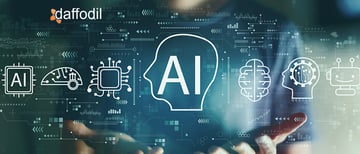-3.jpg?width=700&name=blog%20banner%20(3)-3.jpg)
Over the last half-decade, Artificial Intelligence solutions has made incredible advances in pivotal areas such as vision, video generation, linguistic processing, trend prediction, and so on. While AI attempts to make giant leaps toward matching human intelligence, industry insiders forecast the emergence of Artificial General Intelligence (AGI) as the next obvious step.
Researchers in the field of AI have been constantly dabbling in the theoretical aspect of a machine that can not only do what it is created for but also learn to carry out tasks it was not programmed to do.
In this article, we will talk about the ongoing theories around AGI, what pioneering technology giants have done in this area, the various advancements that will follow its fruition, and what the future holds for this technology.
What Is Artificial General Intelligence (AGI)?
The rationale behind AGI is to create software programs that have the capability to self-understand and eventually implement autonomous self-control across various applications. According to two of the world's foremost voices in the science of AI, Ben Goertzel, and Cassio Pennachin, this technology has the potential to figure out contexts of problems on their own and move on to learning about new problems and solving them.
A recent tweet by Elon Musk predicting the active industry application of AGI by as early as 2029 has forced the tech industry to sit up and take notice.
The concept of AGI has gone from its vague and loosely defined origins to a more goal-driven domain, replete with formulae mapping out the way forward for this technology. On the other end of the AI spectrum is Narrow AI, which simply refers to machines that are programmed for carrying out a limited number of tasks.
Narrow AI vs AGI
Narrow AI model-based machines carry out a specifically designed purpose and only behave as desired when the pre-defined context is set in motion. If you alter the context by the tiniest degree and make it different from the initial behavior specification, the model would lose track of its purpose and lead to errors or the need for some system downtime.
Once the context is changed and the model presents aberrations, there will be a need for human intervention for reprogramming the intended purpose again. Narrow AI does not possess the ability to self-adapt to a new context or environment and learn to carry out a new task.
.jpg?width=700&name=blog%20image%20(3).jpg)
On the other hand, AGI is a highly flexible domain of intelligence with capabilities to adjust according to changing contexts and perform transfer learning across a generalized array of use cases. This technology shifts focus from a specific capability and instead adapts a general intelligence that can understand multiple systems.
Pioneering AI scientists also predict an extended possibility of Super AI which would potentially encompass a much wider spectrum of synthetic intelligence-based capabilities. Some research papers also suggest hypothetical AI models beyond human comprehension such as the uncomputable universal algorithmic agent AIXI.
Customer Success Story: Rebuilding an AI and IoT-based multi-source health tracking app
How Top Global Initiatives Are Advancing Towards AGI
There are several possible technical and theoretical approaches to realizing AGI, but a number of pioneering technology companies are making considerable inroads in this domain. Some of these are companies established across a variety of technologies, while some are more AI-focused. The most significant initiatives include the following:
1)The Hugging Face-Microsoft Collab
Hugging Face, a pioneering AI research firm, and the unbeaten tech giant Microsoft have recently been collaborating to venture into parts unknown in the area of applied AGI. They plan to achieve significant inroads in AGI through democratized machine learning strategies that involve open-source collaboration and unbound platform accessibility.
Hugging Face has ensured full scalability for AGI dependencies by introducing its endpoints on Azure so that the production-environment solutions are scalable. What remains is to make the AGI eventually a system that is faster at sampling, has more modalities, performs computations more efficiently, and has a more systematic and smarter memory bank.
2)Google's DeepMind
Researchers working on Google's DeepMind initiative recently published a paper outlining the multi-modal capability of the AGI that they were working on. The system that the paper explained is known as Gato, which is capable of performing and learning a wide spectrum of activities ranging from understanding spoken language to household chores.
While the fundamental concept behind Gato involves storing and interlinking pre-trained AI tasks and models, the research paper suggests that enough pre-training can make the system capable of evolving into AGI in the actual technical sense. Work is ongoing to make support for S4 buckets a possibility for the AGI so that scaling challenges can be met head-on. Additional challenges related to filtering to protect the system's outcomes from tilting towards hardwired biases must also be accounted for.
3)DarkTrace
DarkTrace is an AI-based cyber security initiative that has researchers working on combining multiple machine learning approaches to create a discernible, purely fundamental form of AGI for the purpose of cyber defense. The digital protection of entire networks of corporations, cloud computing services, emailing nets, and industrial control systems can be automated with this AGI system.
Based on constantly changing and evolving evidence, the system keeps reconfiguring its understanding, and using a self-learning approach, identifies the types of threats it was not originally programmed for. Highly subtle activity can be detected and flagged, helping organizations stop threats before they expand and become more complicated.
4)Graphcore
Graphcore enables advanced-level machine intelligence computations with the help of its patented Intelligence Processing Unit (IPU). Those striving toward a potential breakthrough in AGI technology can make use of the IPU regardless of the field of application, be it robotics, medical research, or finance.
The IPU is a type of processor that specifically speeds up AI computing, so that software architects working with machine intelligence can undertake all types of experimental work, without having to worry about the associated compute resources and bandwidth. The IPU reduces the time taken in AI development cycles, which tend to be lengthy more often than not.
5)MindBridge
MindBridge is building AI that is focused on financial risk mitigation and detection of fraud in financial transactions. The company's flagship product, known as AI Auditor, is a giant leap towards someday realizing AGI. This machine intelligence-driven software was the first one to complete a financial audit with a completely automated workflow.
The technology leveraged by MindBridge is crucial for risk analysis in not just financial systems but also a variety of other applications in medical research, corporate team management, and national defense. A holistic risk analysis system uses a variety of machine learning strategies combining supervised as well as unsupervised learning to get to an outcome.
ALSO READ: Why Machine Translation In NLP Is Essential For International Business?
AGI Is The Next Big Step In The Field Of AI Research
The advent of AGI will be a highly disruptive development that will affect all industries across all verticals deeply. The very way we work is set to change when new inroads are made into this technology.
In these times of rapid technological expansion, a robust AI development strategy can be the factor that sets your business apart from your competitors. You can refer to Daffodil's range of AI application development alternatives to choose the best one that suits the needs of your digital solution.



